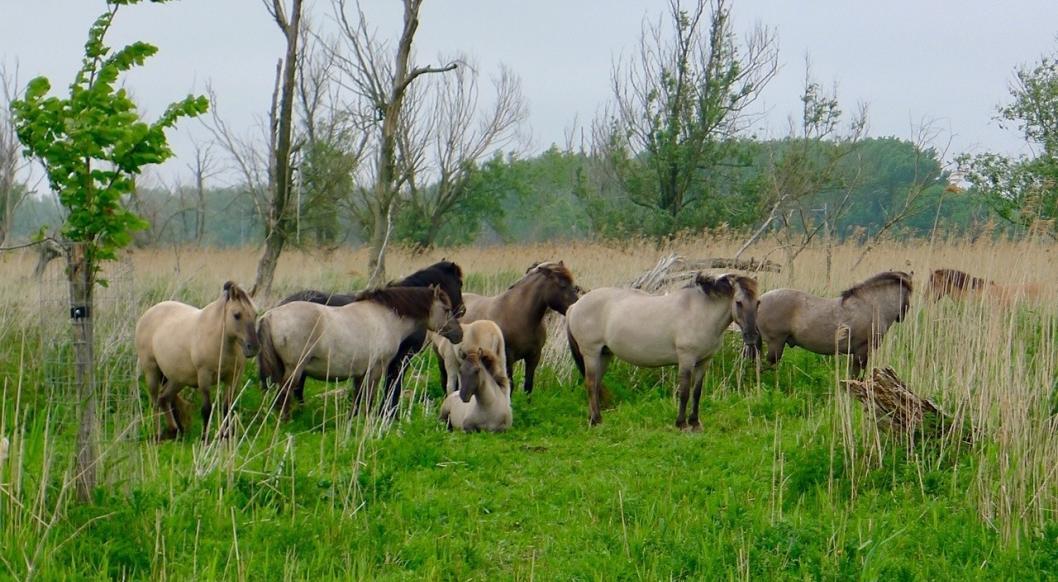
European Experiments in Rewilding: Oostvaardersplassen
By David T. Schwartz
Credit for all images in this article © David Schwartz
One of the most intriguing yet controversial restoration projects in the world today is the Oostvaardersplassen nature preserve in the Netherlands. Having read much about it over the years, including Elizabeth Kolbert’s 2014 New Yorker article “Recall of the Wild”, I finally decided to have a look for myself. I visited on a breezy Tuesday in May 2019, and met with Hans-Erik Kuypers, lead forester with Staatsbosbeheer (SBB), the Dutch agency that oversees the project. Hans-Erik graciously answered my many questions and took me on a tour of the area in one of SBB’s nifty electric vehicles.
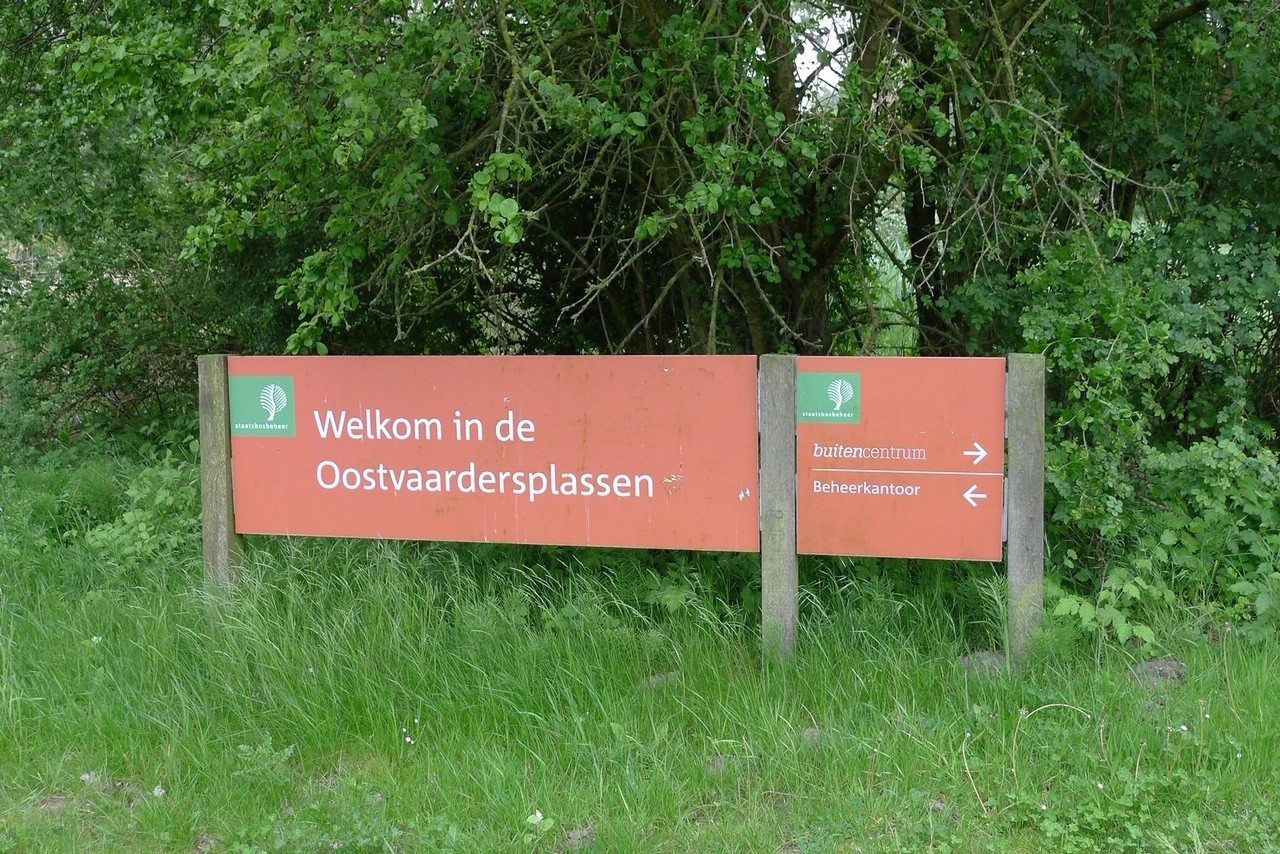
If ever there was a place to confound one’s sense of ‘nature,’ then surely this is it. Oostvaardersplassen (OVP) resides on a man-made polder of land reclaimed from the sea in 1968 to be an industrial park. When the global economy undermined that plan in the 1970s, a group of ecologists – led by Frans Vera – lobbied to have the area designated as a preserve where nature could run wild and recreate the Dutch landscape as it was before humans began intensively cultivating it centuries ago. The reserve would create new habitat for birds and other species displaced from the region by human settlement and development. While the term ‘rewilding’ didn’t yet exist, the fundamental idea was the much same.
As anticipated, not long after the polder was formed greylag geese colonized the area and began shaping the ecosystem. Their feeding habits kept reed grasses low and encouraged the formation of wetland pools, which in turn attracted additional bird species and aquatic life to the area throughout the 1970s. Then concerns arose that the OVP habitat, so conducive to birdlife, was at risk from an influx of willow and other tree saplings that the geese could not eat. To prevent the open grasslands from becoming closed forest, SBB officials, at the urging of Frans Vera, intervened by introducing proxies for two extinct species crucial to the region’s early ecology — the aurochs and the tarpan. The proxy species chosen were Heck cattle for the aurochs and Konik horses for the tarpan, and both were introduced in the mid-1980s. In the 1990s red deer were added, along with 50 red foxes. Introducing ungulates also necessitated perimeter fencing, and after a train line was relocated, the current boundary of the 6000 hectare reserve was established.
Below are photos of the OVP landscape, as seen from the concrete walking path and observation hut.

OVP is now recognized internationally as a haven for birdlife, currently boasting 78 bird species, including greylag and barnacle geese, spoonbill, cormorants, egrets, and several species of ducks. Unexpectedly, a pair of white-tailed eagles began breeding there in 2006, followed by ravens in 2010. The photos below show examples of the wetlands and waterfowl in OVP.
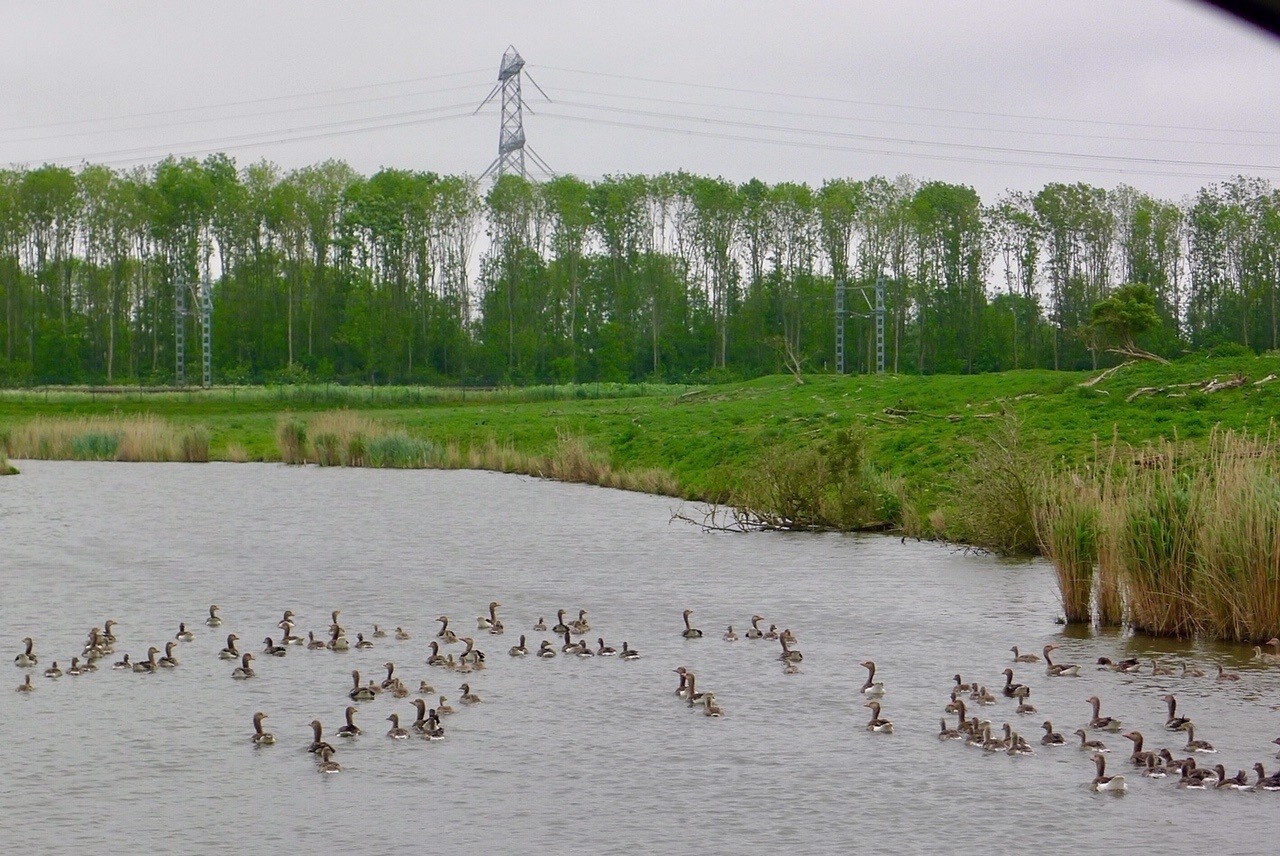
The photos below show two groups of Konik horses that I encountered while hiking, one more aloof and one more inquisitive.
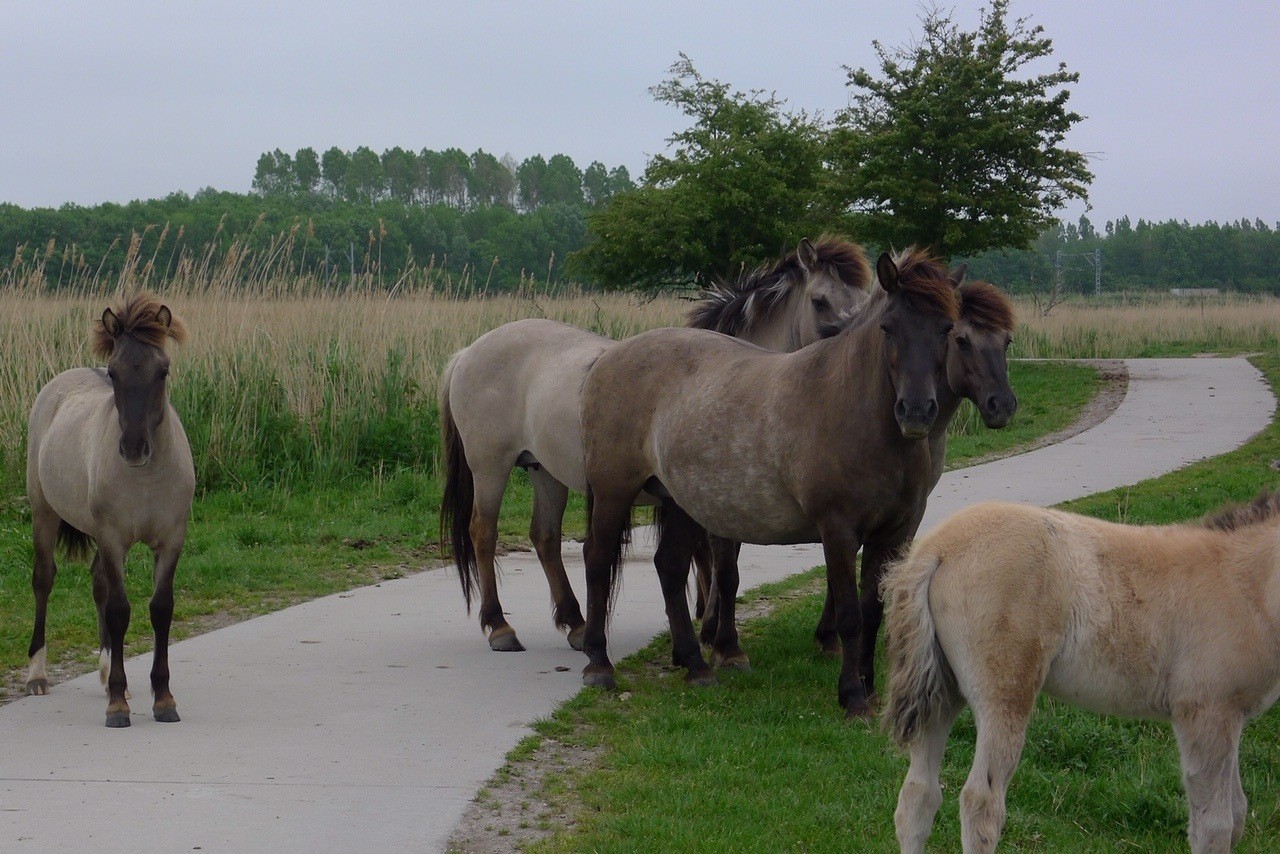

The photo below shows a herd of red deer in the foreground and a herd of Heck cattle in the background. Both species keep their distance from humans, and for the most part human visitors are not allowed into areas where these animals are grazing.
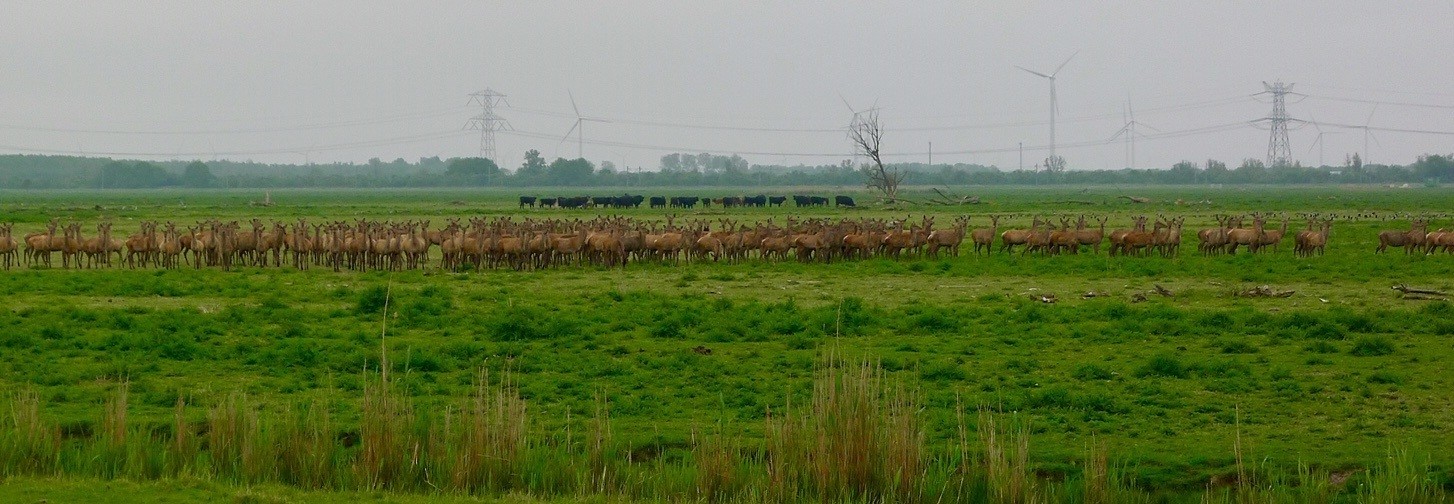
While the electric power lines and wind turbines were initially jarring, I actually came to see them as part of Oostvaardersplassen’s beauty — it’s easy to forget that all of this is happening in one of the most densely developed and populated parts of the world, only 20 miles from Amsterdam!
Yet while the birdlife has been an unequivocal success, all is not rosy in the Oostvaardersplassen. Most of the problems stem from the very success of the introduced fauna. The initial populations of 32 Heck cattle, 18 Konik horses, and 40 red deer had, by 2016, grown into a combined population of over 5300 animals. Because a founding principle of Oostvaardersplassen was that nature should be allowed to take its course, SBB had no prescribed population targets and allowed herd sizes to rise and fall in relation to available foodstuffs. In other words, death and predation were integral to the Oostvaardersplassen ethos. While SBB officials would proactively cull obviously weak animals to avoid further suffering, the death of ponies, cattle, and deer were considered natural trophic events, promoting ecosystem health and providing food for resident foxes, raptors, and other predators. Below is a photo of a horse carcass I encountered that had been picked clean by predators.
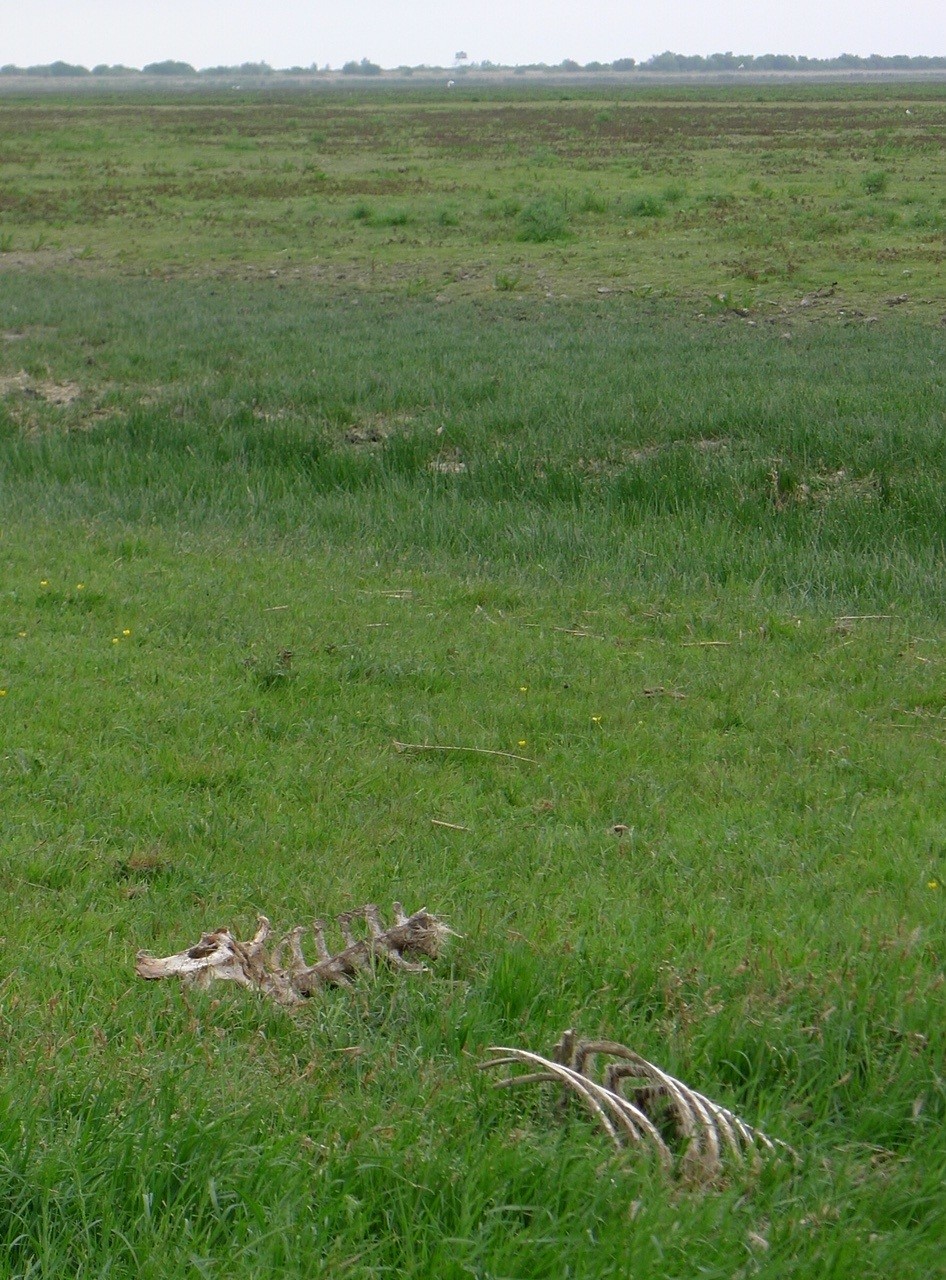
But natural processes can be painful to see, and in 2016, concerned citizens began protesting Oostvaardersplassen as a place of animal cruelty. Protest tactics included picketing, trespassing, and illegally hurling bales of hay over the fencing to feed hungry animals. After continued protests — and an especially harsh winter in 2017, in which over 3000 animals died or were put down – the provincial authority of Flevoland intervened by imposing changes to OVP policies based on recommendations in the Van Geel Commission report. Implemented in December 2018, the new policies call for active population control with specific target numbers for the ungulate populations: 500 deer, 210 Heck cattle, and 550 Konik horses. These targets will be reached through a combination of ‘sloping’ (i.e., culling) weak individuals and relocating excess populations to other countries. (During my visit, a group of 150 ponies had been sequestered in preparation for relocation to Belarus.) Additionally, a 300 hectare ‘shelter area’ is being planted with trees and other native vegetation to protect animals from the cold, and foresters now must make visual contact with every individual ungulate three times a week, assessing its condition according to a Body Condition Score and summoning veterinary care for sick or injured animals. These measures have been applauded by animal welfare advocates and have greatly reduced the protests. On the other hand, some rewilding proponents consider the changes to be a giant step backwards, a move away from rewilding and essentially turning Oostvaardersplassen into a glorified zoo.
While also raising concerns about animal welfare, a recent Rewilding Earth post by Mark Fisher stridently criticized OVP on a more conceptual level. While his broadside has many parts, I take his critique to have three basic elements. First, he questions (and rejects) the scientific assumptions behind the project (Vera’s hypothesis that the pre-historic European landscape was more savannah-like than traditionally assumed). Second, he rejects the use of fenced, domesticated ungulates in any rewilding project, arguing that rewilding “should always be about restoring ecological and evolutionary processes…., with freely living native species.” Third, and more generally, Fisher argues that describing OVP as a rewilding project “risks undermining the meaning of rewilding.” “Rewilding,” he writes, “isn’t something different, ecology isn’t something different, just because it is taking place in Europe. Rewilding is a global issue and must not be put into confusion by those who seek to shift its meaning.”
A Few Reflections
Regarding animal welfare, it can be difficult to sort out how much of the negative public reaction to Oostvaardersplassen was motivated by actual SBB policies and how much was really a reaction to the harshness of nature itself. Death and predation are never easy to see, and OVP’s proximity to major population centers makes some public discomfort inevitable. Nonetheless, it is clear that policies had to change. Rewilding goals do not justify creating situations of great suffering, especially when the affected animals were introduced by human agency. With fences but no migration corridors or carnivores, it is not surprising that things went poorly. In retrospect, the ungulates should probably not have been introduced in an area this small without a firmly established plan for migration corridors (a plan to connect Oostvaardersplassen to other bio-reserves in the region seems to have indefinitely stalled out). While the new population targets will probably reduce animal suffering, the ungulate population will now require human management into perpetuity.
While I agree with many parts of Fisher’s conceptual critique, I disagree with his blanket condemnation of the project. Yes, Vera’s hypothesis is controversial, but rewilding by its very nature involves a certain amount of scientific speculation about the past. As to introducing ungulates, I think Fisher overplays the distinction between domesticated and wild species. Even if Vera may overestimate their effects on the landscape, there is no doubt that aurochs and tarpan functioned in the way he claims. If those functions can be re-established using domesticated proxies, then insisting on ‘wild’ animals seems arbitrary and overly idealistic. Even calling the introduced animals ‘domesticated’ is not fully accurate given that they have been selected because of their morphological and behavioral similarities to their wild predecessors. Fisher ignores the fact that what is possible and appropriate in Wyoming may be very different from what is possible and appropriate in the Netherlands and other densely populated regions. Insisting on only full-bore rewilding, or hewing to some ‘pure’ definition in every instance, is unrealistic and risks doing nothing to improve the future.
In touring Oostvaardersplassen, I found myself wondering over and over: What exactly is this place? Is it a nature preserve or a garden park? Some of both, no doubt. In an ironic twist given its history, SBB foresters recently began planting oak and maple seedlings in small fenced areas to protect them from the herbivores until they get established. Thus, in yet another way, the hand of human intervention continues to weigh heavily on the Oostvaardersplassen ecosystem. If one agrees that rewilding projects should aim to produce self-sustaining ecosystems (i.e., ecosystems that do not require on-going human intervention to maintain their trophic complexity and balance), then OVP clearly falls short. While self-persistence may not be fully realizable in all worthwhile rewilding projects, it is a fundamental measure of success.
Is Oostvaardersplassen a rewilding project at all? Well, it’s hard to ‘rewild’ a polder of land that didn’t even exist until 1968. And OVP certainly is not rewilding in the Foreman/Soule/Noss sense of cores, carnivores, and corridors. A more common term used by the Dutch to describe it is ‘new wilderness,’ or perhaps more aptly, ‘new nature.’ Nonetheless, claiming a plot of industrial land with the intent of creating wild habitat was way ahead of its time in 1968, and it remains something to be celebrated. The original intent was very much one of rewilding, even if the project has struggled to maintain that direction.
This leads to a more general point. While its foundations may be in natural sciences such as ecology, rewilding is about more than its scientific foundations. It is also about the need for humanity to re-conceptualize its relationship with the natural world. It is about increasing our tolerance for sharing the planet with species unlike ourselves, species with interests and agendas different from our own, and who may well pose a danger to us. It is also about recognizing that while we all say we love nature, the harsh realities of nature’s processes (e.g.., predation and starvation) can be fundamentally at odds with our ‘domesticated’ sensibilities. On all these counts, Oostvaardersplassen is an important – if flawed—experiment. Rather than simply perpetuating the wilderness paradigm, it attempts to move us beyond the dualistic idea that humans are somehow outside of nature. Unfortunately, Fisher’s insistence on a canonical and purist definition of rewilding leads him to overlook this value.
I think OVP also says something significant about the human spirit. On the one hand, it firmly reflects the centuries-old Dutch tradition of hyper-controlling nature. Yet this time, that amazing tradition has been set upon the task of repairing nature and creating new possibilities for the future. If rewilding is going to flourish in the long term, we need to know about more than just what will work ecologically. We also need to know about what will motivate broad human participation and engagement with rewilding projects. While the outsized ambitions of Oostvaardersplassen may have led to political protests, they also caught the public’s imagination concerning what is possible. So, while it is easy to target OVP’s numerous flaws and missteps, I share Elizabeth Kolbert’s sentiment that there is something inspiring about the project. Regardless of what one wants to call it, Oostvaardersplassen is exploring important possibilities for our environmental future.
David T. Schwartz is the Mary Frances Williams Professor of Humanities, and Professor of Philosophy, at Randolph College in Lynchburg, VA. His scholarly research is in the field of ‘public philosophy,’ which applies philosophical methods to the understanding of significant public issues. Before focusing on rewilding, Schwartz wrote books on the ethics of consumer choice (Consuming Choices: Ethics in a Global Consumer Age) and government support for the arts (Art, Education, and the Democratic Commitment). At Randolph College, his courses include Ethics and Public Life, Bioethics, Environmental Philosophy, and Philosophy of Art. In 2017, Schwartz held the Garrey Carruthers Endowed Chair in Honors at the University of New Mexico, where he taught a course on rewilding.

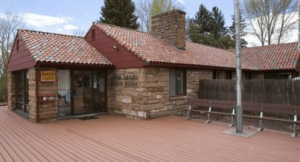
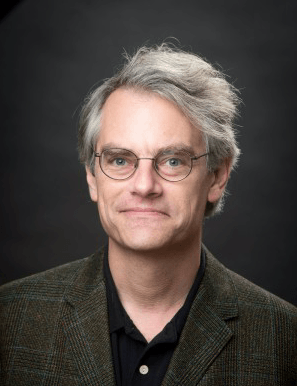
I’ve come to loathe the compromises, the excuses given for why anything less than a sound ecological approach and outcome to restoration of wild nature is acceptable, that it’s just a spectrum of wildness and any point on the continuum is a start. I don’t know why having an idealist or purist attitude has become a legitimate criticism when compromise only benefits people over wild nature; when there is never any intention to move up the continuum. Where is the morality in that, the ethical commitment that recognises the ecological reality? Empathy for wild nature must always be at the high end of the ethical spectrum and should never be dragged down and diluted by anthropocentrism and its mechanisms of domination.
How much does wild nature mean to you? Self-willed land 24 January 2020
http://www.self-willed-land.org.uk/articles/ecocentric.htm
What would you do in Australia to deal with disastrous introductions like rabbits, cane toads, cat, foxes (intending to control rabbits), cattle, sheep and even camels although European settlers were arguably the worst invasive species? Rewilding large areas would have to start with massive culls I suspect and fundamentalist morality could be entering a minefield.